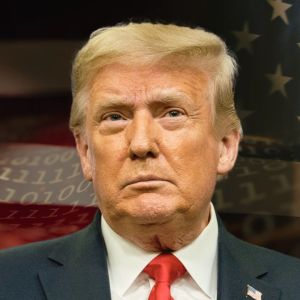Donald Trump’s number one economic goal has been to see interest rates lower. But the real problem isn’t Jerome Powell. It’s the bigger mess sitting underneath the U.S. economy: too much debt, too many deficits, and a shrinking savings pool caused by demographic changes. According to Bloomberg Economics, the ten-year Treasury rate, the one that affects mortgages and business loans, is more likely to stay above 4.5% than drop below it, no matter who runs the Fed. For over thirty years, borrowing costs fell steadily. Washington could spend freely without crashing the system. Home prices soared, stocks surged, and money was cheap. That’s over. Now the U.S. is looking at a future where interest payments alone cost more than the Pentagon’s entire budget. Mortgage rates are at 7%, and real estate is choking. But Trump thinks that by replacing Powell, he can “fix everything.” That’s not how this works. Trump wants control of rates, but global savings are drying up Trump has been pounding the table for a new Fed chair who will cut rates fast. After Fed Governor Adriana Kugler left early, he saw his chance. By putting a loyalist in her seat, he’s hoping to tilt the central bank toward his agenda. He’s also been threatening Powell publicly, calling him “TOO ANGRY, TOO STUPID, & TOO POLITICAL.” Short-term rates may come down in September, especially with the job market showing cracks, but that won’t matter much if long-term rates keep climbing. Why are they going up? Because the world’s savings pool is collapsing. The Baby Boomers, who built it up, are retiring and spending their pensions. China isn’t buying U.S. debt like it used to. Its reserves dropped from $4 trillion to $3.3 trillion since 2014. That’s a big hole in demand. And Saudi Arabia is moving its money away from Treasuries and into its own mega projects, like the futuristic Neom city. Even oil-rich petrostates are done parking cash in Washington. The U.S. made things worse. In 2022, after freezing $300 billion in Russian assets, the government turned Treasury bonds into weapons. That scared other countries. If the U.S. can grab Russia’s money, they can do it to anyone. Then there’s the Fed itself. For decades, presidents from Ronald Reagan to Barack Obama respected its independence. That’s what made investors feel safe, no one wants to put their money into a central bank that looks politically rigged. Decades of low rates were driven by savings surpluses and weak demand From the early 1980s through the 2010s, interest rates kept falling. The reason? There was too much money chasing too few places to put it. Boomers saved for retirement. China and other countries ran big trade surpluses and used the earnings to buy Treasuries. The oil exporters did the same. Tech was cheap, and growth was slow. All this meant a lower “natural rate” of interest. Bloomberg Economics says the natural rate fell from around 5% in the 1980s to 1.7% in 2012. But that whole setup is gone now. Boomers are leaving the workforce. China is letting its currency float, so it doesn’t need to buy dollars to keep it down. Saudi Arabia is betting on the future, not financing U.S. debt. The forces that kept rates low are in reverse. Government borrowing is now out of control. U.S. debt is close to 100% of GDP. In 2001, it was just over 30%. Defense spending is rising again. After Russia invaded Ukraine, Europe’s NATO members agreed to raise their defense budgets to 3.5% of GDP. Bloomberg estimates that will add $2.3 trillion to Europe’s debt in the next ten years. Since global investors treat French and German bonds as substitutes for U.S. Treasuries, that also pushes U.S. rates higher. AI is another drain. Building data centers, upgrading power grids, and reworking supply chains will take real money. Governments are competing with businesses for capital, and nobody’s saving like they used to. The natural rate is moving up. Bloomberg Economics now puts it at 2.5% and says it could hit 2.8% by 2030. That would keep ten-year Treasuries between 4.5% and 5%, even in the best case. If things get worse, the rate could spike to 6% or more. That’s not something Trump can fix with a personnel change. Cryptopolitan Academy: Want to grow your money in 2025? Learn how to do it with DeFi in our upcoming webclass. Save Your Spot















